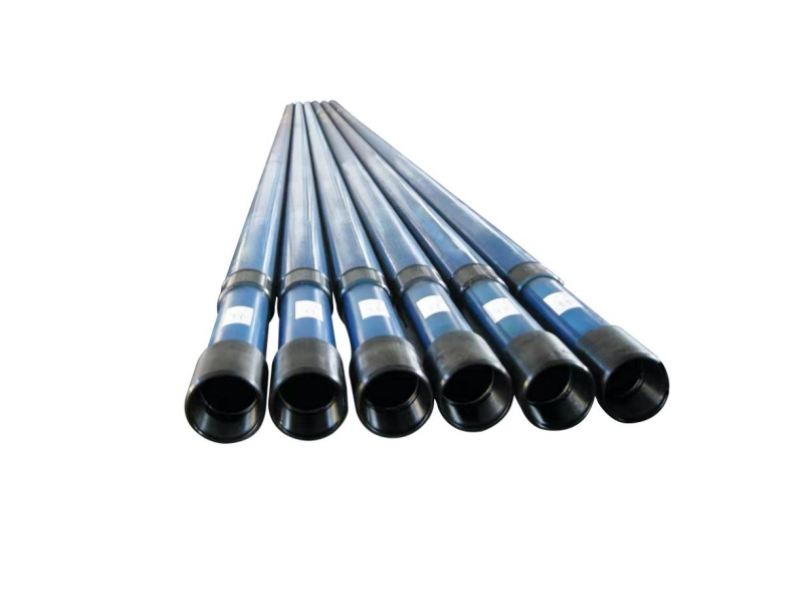Designed in strict compliance with API 11AX standards, API tubing pumps utilize a one-piece rough barrel and precision grinding to ensure a precise fit with the plunger. They utilize high-strength construction, wear-resistant alloy materials, and modular wear parts.
Operating Principle of the API Tubing Pump:
API tubing pumps primarily consist of sucker rods, upper and lower flow valves, plungers, pump barrels, and inlet valves.
The operating principle is that the sucker rod drives the plunger to reciprocate within the pump barrel, thereby lifting liquid:
Upstroke: As the plunger moves upward, the lower flow valve closes and the upper flow valve opens, allowing liquid in the pump barrel to flow into the tubing as the plunger moves upward.
Downstroke: As the plunger moves downward, the upper flow valve closes and the lower flow valve opens, allowing formation fluid to enter the pump barrel through the inlet valve.
The alternating opening and closing of the valve system allows continuous, unidirectional lifting of liquid, achieving efficient and stable extraction.
Applications and Importance:
API tubing pumps are widely used in:
Medium-deep wells: Suitable for operating environments with deep wells and high fluid pressures.
Sand-laden wells: The pump's wear-resistant construction effectively resists sand erosion.
High-frequency wells: The modular design facilitates quick replacement of wear parts, reducing downtime.
In reservoirs with insufficient natural pressure, API tubing pumps are essential equipment for ensuring continuous well production. They not only improve the economic viability of marginal wells but also provide a reliable artificial lift solution for efficient oilfield development.

Environmental and Economic Value:
The API tubing pump's wear and corrosion resistance significantly reduces maintenance frequency and downhole operations, thereby reducing:
Operational and maintenance costs
Losses from well downtime
Environmental risks at the wellsite (such as fluid leaks and frequent equipment handling).
Combined with a long-life design and high-efficiency operation, API tubing pumps help oilfields maintain economic profitability while reducing their carbon footprint.
1. What is an API tubing pump?
An API tubing pump is a pumping device installed inside the oil pipeline. It uses a sucker rod to drive a reciprocating plunger, lifting crude oil from the wellbore to the surface. Because its structure complies with API standards, it offers high versatility and reliability.
2. How does an API tubing pump work?
During operation, the tubing pump's barrel is fixed in the tubing. The sucker rod drives the piston up and down, alternately opening and closing the suction and discharge valves, thereby gradually lifting well fluid to the surface. This ensures stable oil production even when downhole pressure is insufficient.
3. What are the main components of an API tubing pump?
A tubing pump consists of a barrel, plunger, bushing, fixed valve (suction valve), discharge valve, and a corresponding sucker rod. These components work together to lift and discharge oil.
4. Why is a tubing pump called a "tubing pump"?
Because the barrel of a tubing pump is directly installed in the tubing, and the piston is fed into the pump body by the sucker rod, it is often referred to in the industry as a "tubing pump."
5. Where are API tubing pumps commonly used?
They are often used in shallow or high-yield wells, and are also suitable for wells with high sand content. When production requirements are high and pump inspections are infrequent, tubing pumps are a more economical option.
6. What is the approximate production capacity of an API tubing pump?
For the same tubing diameter, tubing pumps can use larger diameter pump barrels, resulting in generally greater displacement than rod pumps. Actual production capacity depends on pump diameter, stroke length, and stroke frequency, but generally meets the production needs of medium- to high-yield wells.
7. How is an API tubing pump driven?
A tubing pump uses a surface pumping unit or electric motor to drive the sucker rod, which in turn drives the downhole plunger to reciprocate and produce oil.
8. How do modern API tubing pumps differ from traditional models?
Modern tubing pumps utilize more wear-resistant bushing materials, improved valve structures, and sand and gas lock prevention designs. Some manufacturers also offer modular construction for rapid on-site repair and replacement.
9. What is the environmental impact of API tubing pumps?
As downhole mechanical equipment, tubing pumps inherently have a relatively low environmental impact. However, in sandy or corrosive wells, poor sealing can cause wellhead leakage. New sealing and anti-corrosion technologies can effectively reduce these risks.
10. Are API tubing pumps still applicable in modern oilfield development?
Yes. Despite the continued development of new lift methods such as progressive cavity pumps and electric submersible pumps, tubing pumps remain an economical, reliable, and irreplaceable method for pumping oil in shallow wells, high-yield wells, or in sandy conditions.
Our company specializes in the production of the CYB-[d]TL(F1) series API tubing pumps, which strictly comply with API 11AX standards and are widely used in oilfields both domestically and internationally.
Core Advantages:
High-strength material: Extends pump barrel life by 2-3 times
Wear and corrosion resistance: Nickel-based coating and ceramic valve design
Modular maintenance: Quickly replace parts at the wellhead
Customized solutions: Tailored to individual well conditions
We are committed to providing customers with highly reliable, low-maintenance artificial lift solutions for oil wells.

